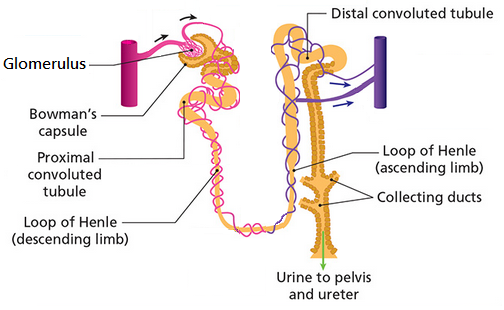Question
- Leaving Certificate Biology (Higher) 2020: Q13
- Back to the question >
Answer
(a)
(i) Homeostasis is the ability of an organism to regulate its internal environment.
(ii) Homeostasis is important because it allows an organism to function independently of its external environment.
(iii) Excretion is the removal of the waste products of metabolism from an organism.
(b)
(i) Urea is produced in the liver.
(ii) Urea is derived from the breakdown of proteins.
(iii)
- The Bowman’s capsule is in the cortex.
- The Loop of Henle is in the medulla.
- A: Ureter.
(iv) The Nephron

(c)
(i) There are proteins in the plasma but none in the glomerular filtrate. This is because proteins are too big to be filtered out through the glomerulus and so remain in the blood.
(ii)
- The same concentration of glucose is seen in both the plasma and the glomerular filtrate. This is because glucose is so small that it is all filtered out through the glomerulus and passes into the glomerular filtrate.
- There is glucose in the glomerular filtrate but none in the urine. This is because all the glucose is reabsorbed into the blood.
(iii)
- A high salt intake will result in urine that has a small volume and a high solute content.
- The kidney’s role is to ensure the concentration of the tissue fluid is the same as the cytoplasm of the cells. A high salt intake causes the tissue fluid to be more concentrated than the cytoplasm. This would cause water to leave the cells by osmosis. To prevent this and restore the concentration balance, a large amount of water is reabsorbed into the blood from the glomerular filtrate. This produces a small volume of very concentrated urine.
